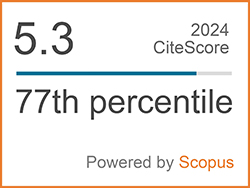Sacrificial-Layer Technique Fabrication and Characterization of Membrane Pneumatic Actuators for Flow Control in Microfluidics – Reproducibility Assessment
Abstract
Keywords
[1] J. M. Ayuso, M. Virumbrales-Muñoz, J. M. Lang, and D. J. Beebe, “A role for microfluidic systems in precision medicine,” Nature Communications, vol. 13, no. 1, 2022, Art. no. 3086.
[2] R. Driver and S. Mishra, “Organ-On-A-Chip technology: An in-depth review of recent advancements and future of whole body-on-chip,” Biochip Journal, vol. 17, pp. 1–23, 2023.
[3] A. Valizadeh and A. Y. Khosroushahi, “Single-cell analysis based on Lab on Chip fluidic system,” Analytical Methods, vol. 7, no. 20, pp. 8524–8533, 2015.
[4] U. A. Gurkan et al., “Next generation microfluidics: Fulfilling the promise of lab-on-a-chip technologies,” Lab on a Chip, vol. 24, no. 7, pp. 1867–1874, 2024.
[5] P. Panuska et al., “Advanced microfluidic platform for tumor spheroid formation and cultivation fabricated from OSTE+ polymer,” Biochip Journal, vol. 18, pp. 393–409, 2024.
[6] C. D. Chin, V. Linder, and S.K. Sia, “Lab-on-a-chip devices for global health: Past studies and future opportunities,” Lab on a Chip, vol. 7, no. 1, pp. 41–57, 2007.
[7] T. Wongpakham et al., “Development of pyramidal microwells for enhanced cell spheroid formation in a cell-on-chip microfluidic system for cardiac differentiation of mouse embryonic stem cells,” Cells, vol. 13, no. 24, p. 2132, 2024.
[8] D. Popa, “Microactuators,” in Encyclopedia of Microfluidics and Nanofluidics, 2008, pp. 1000–1003.
[9] W. O. Kwang and H. A. Chong, “A review of microvalves,” Journal of Micromechanics and Microengineering, vol. 16, no. 5, 2006, Art. no. R13.
[10] M. R. A. Fuaad, M. N. Hasan, M. I. A. Asri, and M. S. M. Ali, “Microactuators technologies for biomedical applications,” Microsystem Technologies, vol. 29, no. 7, pp. 953–984, 2023.
[11] C. Y. Chen, C. H. Chen, T. Y. Tu, C. M. Lin, and A. M. Wo, “Electrical isolation and characteristics of permanent magnet-actuated valves for PDMS microfluidics,” Lab on a Chip, vol. 11, no. 4, pp. 733–737, 2011.
[12] J. D. Tice, T. A. Bassett, A. V. Desai, C. A. Apblett, and P. J. A. Kenis, “A monolithic poly(dimethylsiloxane) electrostatic actuator for controlling integrated pneumatic microsystems,” Sensors and Actuators A: Physical, vol. 196, pp. 22–29, 2013.
[13] A. V. Desai, J. D. Tice, C. A. Apblett, and P. J. A. Kenis, “Design considerations for electrostatic microvalves with applications in poly(dimethylsiloxane)- based microfluidics,” Lab on a Chip, vol. 12, no. 6, pp. 1078–1088, 2012.
[14] K. Pitchaimani, B. C. Sapp, A. Winter, A. Gispanski, T. Nishida, and Z. H. Fan, “Manufacturable plastic microfluidic valves using thermal actuation,” Lab on a Chip, vol. 9, no. 21, pp. 3082–3087, 2009.
[15] J. Atencia, G. A. Cooksey, A. Jahn, J. M. Zook, W. N. Vreeland, and L. E. Locascio, “Magnetic connectors for microfluidic applications,” Lab on a Chip, vol. 10, no. 2, pp. 246–249, 2010.
[16] J. Casals-Terré et al., “Design, fabrication and characterization of an externally actuated ON/OFF microvalve,” Sensors and Actuators A: Physical, vol. 147, no. 2, pp. 600–606, 2008.
[17] X. Liu et al., “Theoretical and experimental studies of a PDMS pneumatic microactuator for microfluidic systems,” Energies, vol. 15, no. 22, p. 8731, 2022.
[18] X. Liu et al., “Microfluidics chips fabrication techniques comparison,” Scientific Reports, vol. 14, 2024, Art. no. 28793.
[19] H. G. Shin, W. K. Chung, and K. Kim, “Soft and flexible robot skin actuator using multilayer 3D pneumatic network,” Nature Communications, vol. 16, 2025, Art. no. 5575.
[20] J. C. McDonald and G. M. Whitesides, “Poly(dimethylsiloxane) as a material for fabricating microfluidic devices,” Accounts of Chemical Research, vol. 35, no. 7, pp. 491–499, 2002.
[21] K. Khanafer, A. Duprey, M. Schlicht, and R. Berguer, “Effects of strain rate, mixing ratio, and stress–strain definition on the mechanical behaviour of the polydimethylsiloxane (PDMS) material as related to its biological applications,” Biomedical Microdevices, vol. 11, no. 2, pp. 503–508, 2008.
[22] C. F. Chen and K. Wharton, “Characterization and failure mode analyses of air plasma oxidized PDMS–PDMS bonding by peel testing,” RSC Advances, vol. 7, no. 3, pp. 1286–1289, 2017.
[23] C. H. Chiou, T. Y. Yeh, and J. L. Lin, “Deformation analysis of a pneumatically activated polydimethylsiloxane (PDMS) membrane and potential micro-pump applications,” Micromachines, vol. 6, no. 2, pp. 216–229, 2015.
[24] X. Qian et al., “Characterizing the deformation of the polydimethylsiloxane (PDMS) membrane for microfluidic system through image processing,” Micromachines, vol. 7, no. 5, p. 92, 2016.
[25] Y. Yuan, Y. Yalikun, N. Ota, and Y. Tanaka, “Properly investigation of replaceable PDMS membrane as an actuator in microfluidic device,” Actuators, vol. 7, no. 4, p. 68, 2018.
[26] A. Nanaware et al., “Pneumatic controlled nanosieve for efficient capture and release of nanoparticles,” Journal of Vacuum Science & Technology B, vol. 40, 2022, Art. no. 063002.
[27] B. J. Koo et al., “Micromachined PVA (poly(vinyl alcohol)) sacrificial layer for facile and scalable demonstration of highly reproducible porous-type pressure sensor,” ACS Applied Polymer Materials, vol. 6, pp. 11788–11797, 2024.
[28] J. Hong, J. Gong, Q. Li, Z. Deng, and L. Gui, “A handy reversible bonding technology and its application on fabrication of an on-chip liquid metal micro-thermocouple,” Lab on a Chip, vol. 21, pp. 4566–4573, 2021.
[29] Z. Ye, Q. Li, R. Zhang, P. Zhang, and L. Gui, “Fabrication of a thin PDMS film with complex liquid metal electrodes embedded and its application as skin sensors,” RSC Advances, vol. 12, pp. 8290–8299, 2022.
[30] M. Li et al., “Fabrication and characterization of high-sensitivity, wide-range, and flexible MEMS thermal flow velocity sensors,” Microsystems & Nanoengineering, vol. 10, 2024, Art. no. 102.DOI: 10.14416/j.asep.2025.11.004
Refbacks
- There are currently no refbacks.
 Applied Science and Engineering Progress
Applied Science and Engineering Progress







